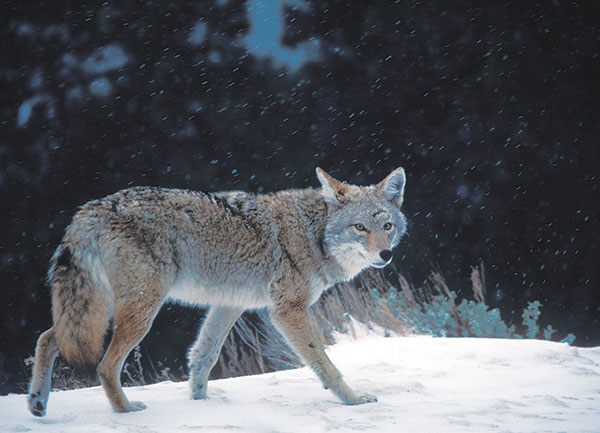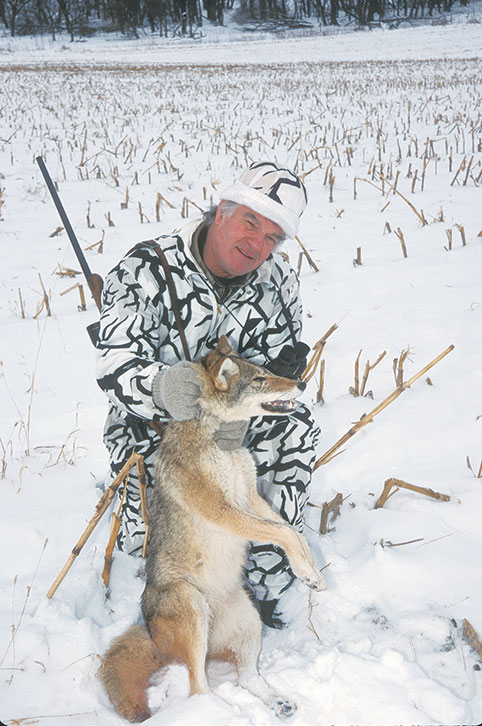 Predator Hunting: Using the Winter Wind
Predator Hunting: Using the Winter Wind
By Predator Hunting Editor Judd Cooney

The big dog coyote wasn’t having much luck in the open valley bottom. The meadow mice and voles were nested under 8 inches of snow, and I hadn’t seen him catch a single critter.
I’d glassed the coyote for a half-hour from a logging road on the far side of the valley, some 600 yards away, and it would have been an ideal midmorning calling opportunity if it hadn’t been for a stiff breeze blowing from my side of the valley toward the coyote. If I set up at the base of the hill below where I was parked, there was a good chance, if the coyote could even hear my calling, that he’d circle directly downwind and pick up my scent before getting within shooting range.
However, I always figure nothing ventured, nothing gained. So I kept watching.
The coyote finally stopped on a little knoll, looked around, and then curled up for a nap in the sun. His back was to the wind, where he could watch the downwind side yet still smell any danger approaching from his backside. I watched the dozing coyote for maybe 45 minutes, just to make sure he was serious about this midday siesta. Every ten minutes or so, he’d raise his head, scan the meadow, and then bury his head back in his fuzzy tail.
I figured my best chance would be to sneak down to the edge of the timber below the road, wait until the coyote took a look around and went back to napping, and then bust my butt to get as close as possible before he looked up again. There was no cover in the open valley bottom, but my snow camo would let me blend in, at least somewhat. By taking the shortest and fastest route, which happened to be directly upwind, and using my ever-present talcum powder “windicator” to stay just off the direct wind path to the sleeping coyote, I just might pull it off.
I got down to the edge of the timber and waited. On cue, the coyote raised his head and scanned the area. The second he put his head back down, I started across the meadow. I kept a constant check on the wind to make sure my scent was carrying slightly downwind of the coyote and also watched the coyote for any movement. The wind and snow covered any sounds of my approach, and I got within 50 yards before deciding not to press my luck. In my early fox hunting days, I’d gotten within rock-throwing distance of sleeping fox using the same winter-wind doping tactic.
I settled into a comfortable sitting position and waited for the coyote’s next move. The completely unaware coyote raised his head, looked around, and then did a double take when he saw the clump of something that hadn’t been there a few minutes before. He popped to his feet, turned broadside, and a 52-grain Sierra hollow point put the prime mountain coyote into permanent sleep mode.
Wind probably puts the kibosh on more winter predator stands than any other factor, yet many of these hunts could be saved if the hunter knew how to make the wind work in his favor. Generally, winds and breezes are more stable and predictable in winter than in warmer seasons.
However, there are situations in which the winter wind will do the unpredictable.
While bowhunting deer on a cold December morning, I got a first-hand view of those unfathomable nuances. I’d set up at the edge of a harvested cornfield where an oxbow in the river bottom narrowed the timber and created a well-used thoroughfare for whitetails and muleys.
There also was a heavily traveled trail along the edge of the field, so I set up at the base of a cottonwood where I could overlook both areas. To hedge my bets, I set a couple of smoke scent sticks just off the trail at the edge of the field.
An hour after I got positioned, the sun came up and backlit the smoke drifting from the scent sticks. There was no discernible breeze in the frigid cold, yet the smoke drifted slowly out into the field, about 3 feet above the ground in a 10-foot wide cloud. At 40 yards, the translucent cloud turned and drifted back up the field for another 50 yards, where it turned again and drifted back toward the river bottom. It crossed all of the trails 50 yards upstream from where I sat. Any deer following those trails would have winded me 50 yards out, and there was no way I could have played or even ascertained that anomaly.
There are times when the wind, and the critters, are going to win, and there isn’t a darn thing you can do about it.
Fortunately, this isn’t the norm, and winter wind can be a bit more hunter friendly when played properly.
I was calling predators during early January and had set up with a hunting partner on a point of timber overlooking a harvested cornfield adjacent to a tract of timber along a creek bottom. On our downwind backside, a 50-yard-wide strip of snow-covered alfalfa bordered a half-mile section of disked cropland. The bright winter sun had melted the snow off the black field dirt, but a light blanket of white stuff still covered the frost-killed alfalfa.
A slight but steady breeze hit us head on, nothing my Foxpro CS24 electronic caller couldn’t cut through.
Never one to fully trust a predator to follow the script, I occasionally scrooched around and scrutinized the open country downwind to our rear.
I generally stay on stand 20 to 30 minutes in good predator country, especially when I know the call can really reach out across the countryside.
At 20 minutes, I took a last look and spotted movement almost half a mile away. A quick check with binocs revealed a pair of red fox headed our way across the disked field. We wiggled around into shooting position, and I cut down on the caller’s volume.
“When they get to 100 yards, I’ll yip on my mouth call, and the minute they stop, take the right-hand critter and I’ll take the one on the left,” I whispered to my excited companion.
The two reds were well aware they lived in coyote country and didn’t like being in the open and vulnerable to the larger predator. However, the cottontail distress sounds kept them coming, albeit cautiously. At 100 yards, they were still well out in the disked field when my soft yip stopped both in their tracks.
My compadre claimed that the report of my .223 Bushmaster caused him to jerk his shot off. I figured it was more a case of “fox fever.”
My fox hit the ground, obviously down and out, and I immediately swung on the fast-fleeing survivor. Fortunately, it was headed straight away and gave me a fairly easy running shot at 150 yards. I’ve really come to appreciate the deadly accuracy, fast handling, and speedy follow-up shots of AR-type predator rifles.

“Why didn’t you let them get closer,” my subdued partner asked as we headed across the snowy alfalfa to retrieve the fox. As an answer, I pulled out my powder bottle and puffed out a dense cloud of talc that drifted slowly toward the open field, close to the ground as one might expect. When we got close to where the alfalfa met the black dirt of the disked field, I again squirted out a cloud of talc. This cloud moved to the edge of the field, and when it got above the black dirt, immediately started rising. The warming rays of the winter sun had been absorbed by the black dirt and raised its temperature just enough to create an updraft that carried the scent up and away from the ground and a fox’s discerning nose. If I had let those fox get closer to the edge of the snow-covered alfalfa, there was a good chance they’d have “winded” us and spooked.
This updraft phenomenon occurs under many circumstances and can be taken advantage of by the savvy late-season predator hunter.
I count the little powder bottle among my most important tools and have one stashed in my truck, daypack, call satchel and every gun kit. I buy inexpensive bulk talcum powder and then transfer it to the small squeeze bottles. I use scented powder rather than unscented as I want to be able to smell the stuff myself. It makes me aware of subtle shifts in wind after I get set up. I figure a critter that gets close enough to catch a whiff will already have scented me, and I never have seen sign that the talc spooked an incoming fox or coyote.
When I first started predator hunting, back in the Dark Ages, I wouldn’t think of setting up to call downwind. Now I do it all of the time—as long as I think I know exactly where the wind is blowing. A hunter’s scent stream, under most conditions, only covers a few degrees, and I’ve collected many a pelt by taking a shot before the critter hit that scent stream.
When picking a calling stand late in the season, I figure a high percentage of predators are liable to be call-shy and if given half a chance will circle downwind to scent check the area before coming in for a closer look. I prefer to set up where I can see the downwind side, to cut down on the chance that a leery predator will sneak in and then back out unobserved. Shots downwind are often a bit on the long side, but better a long shot than no shot at all.
In the mountains, winds are a lot more erratic and unpredictable. Generally, they rise uphill as the sun rises and then flow downhill as the sun sets. But you get updrafts and downdrafts, so there are no hard and fast rules other than to use the powder bottle often, to try to keep on top of the situation. Also, in general, a wind that blows across a steep vertical ridge or hilltop will stay above a predator’s scenting zone, a factor I’ve taken advantage of many times when calling in rough country and also when placing baits for predators.
By studying and learning to play the wind, you can vastly improve your chances. So get out there and add some prime winter fur to your collection.